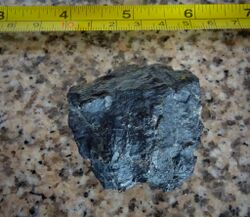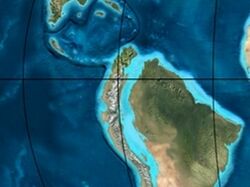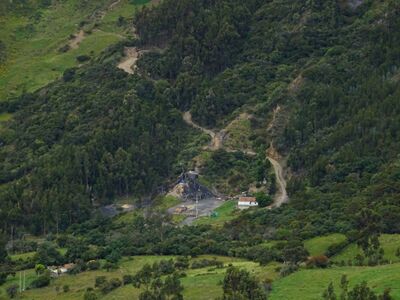Earth:Guaduas Formation
| Guaduas Formation Stratigraphic range: Maastrichtian-Paleocene ~68–60 Ma | |
|---|---|
 Coal from the Guaduas Formation, Páramo de Ocetá | |
| Type | Geological formation |
| Underlies | Cacho Formation |
| Overlies | Guadalupe Gp. Arenisca Labor-Tierna Fm. |
| Thickness | up to 1,090 metres (3,580 ft) |
| Lithology | |
| Primary | Shale |
| Other | Sandstone, coal |
| Location | |
| Coordinates | [ ⚑ ] : 5°05′N 74°36′W / 5.083°N 74.6°W |
| Region | Middle Magdalena Basin Magdalena River Valley Altiplano Cundiboyacense Eastern Ranges, Andes |
| Country | |
| Type section | |
| Named for | Guaduas |
| Named by | Hubach |
| Location | Guaduas |
| Year defined | 1931 |
| Coordinates | [ ⚑ ] 5°05′N 74°36′W / 5.083°N 74.6°W |
| Paleocoordinates | [ ⚑ ] 0°36′N 52°30′W / 0.6°N 52.5°W |
| Region | Cundinamarca, Boyacá |
| Country | |
 Paleogeography of Northern South America 65 Ma, by Ron Blakey | |
The Guaduas Formation (Spanish: Formación Guaduas, K2P1G, K2E1G, KPgg, KTg, TKg, Ktg) is a geological formation of the Middle Magdalena Basin and the Altiplano Cundiboyacense, Eastern Ranges of the Colombian Andes. The predominantly shale with coalbed formation dates to the Late Cretaceous and Paleogene periods; Maastrichtian-Paleocene epochs, and has a maximum thickness of 1,090 metres (3,580 ft). Fossils of Coussapoa camargoi, Ficus andrewsi, Berhamniphyllum sp. and Archaeopaliurus boyacensis have been found in coalbeds in Zipaquirá and Tasco, Boyacá.
Etymology
The formation was first described by Hettner in 1894 and named in 1931 by Hubach after Guaduas, Cundinamarca, former northern territory of the Panche.[1]
Description
Lithologies
The Guaduas Formation consists mainly of shales with intercalated sandstone beds. The formation contains coalbeds that are widely explored in the area.[2] Fossil remains of Coussapoa camargoi, Ficus andrewsi, Berhamniphyllum sp. and Archaeopaliurus boyacensis have been found in coalbeds in Zipaquirá and Tasco, Boyacá.[3][4][5]
Stratigraphy and depositional environment
The Guaduas Formation unconformably[6] overlies the Arenisca Labor-Tierna Formation of the Guadalupe Group and is overlain by the Cacho Formation. The age has been estimated to be Upper Maastrichtian-Lower Paleocene, spanning the K-T boundary.[7] The Guaduas Formation is thicker in Cundinamarca than in Boyacá. This has been explained by a decrease in subsidence and a higher amount of erosion in the northern area of original deposition.[8] The lateral thickness variations are thought to be the result of the movement of the Soapaga Fault.[9] The formation has been deposited in a coastal plain setting.[4]
Outcrops
Lua error in Module:Location_map at line 522: Unable to find the specified location map definition: "Module:Location map/data/Altiplano Cundiboyacense" does not exist. The Guaduas Formation is apart from its type locality, found in the Eastern Hills of Bogotá, the Ocetá Páramo and many other locations in the Eastern Ranges, such as Granada,[10] the Dintel Synclinal north of Facatativá,[11] the Suesca Synclinal,[12] east of Junín,[13] and surrounding Lake Tota.[14] The northeast-southwest Canocas Fault crosscuts the Guaduas Formation near San Cayetano.[15] The synclinals of the Río Frío, Neusa, Zipaquirá, Checua-Lenguazaque, Sesquilé, Sisga, Subachoque, Teusacá and Usme and Soacha are composed of the Guaduas Formation.[2] The Suba Hills are entirely composed of the Guaduas Formation.[16] The formation also has outcrops in the Sumapaz Páramo.[17]
Regional correlations
Gallery
-
Coal mining in the Guaduas Formation
Ocetá Páramo
See also
 Geology of the Eastern Hills
Geology of the Eastern Hills Geology of the Ocetá Páramo
Geology of the Ocetá Páramo Geology of the Altiplano Cundiboyacense
Geology of the Altiplano Cundiboyacense
Notes and references
Notes
References
- ↑ Montoya & Reyes, 2005, p.51
- ↑ 2.0 2.1 Montoya & Reyes, 2005, p.52
- ↑ Coussapoa camargoi, Ficus andrewsi at fossilworks.org
- ↑ 4.0 4.1 Berhamniphyllum sp. & Archaeopaliurus boyacensis at fossilworks.org
- ↑ 'Archaeopaliurus boyacensis' in the Paleobiology Database
- ↑ Villamil, 2012, p.208
- ↑ Montoya & Reyes, 2005, p.54
- ↑ Mariño & Amaya, 2016, p.B9
- ↑ Amaya et al., 2010
- ↑ Plancha 246, 1998
- ↑ Plancha 227, 1998
- ↑ Plancha 190, 2009
- ↑ Plancha 191, 1998
- ↑ Plancha 192, 1998
- ↑ Planchas 171 & 191
- ↑ Geological Map Bogotá, 1997
- ↑ (in Spanish) Geología y geomorfología - Salida de Campo: Región Llanos Orientales
Bibliography
- Amaya, Erika; Jorge Mariño, and Carlos Jaramillo. 2010. Litofacies y ambientes de acumulación de la Formación Guaduas en al parte central de la Cordillera Oriental - implicaciones paleogeográficas. Boletín de Geología, Universidad Industrial de Santander 32. _. Accessed 2017-03-16.
- García González, Mario; Ricardo Mier Umaña; Luis Enrique Cruz Guevara, and Mauricio Vásquez. 2009. Informe Ejecutivo - evaluación del potencial hidrocarburífero de las cuencas colombianas, 1-219. Universidad Industrial de Santander.
- Mariño M., Jorge E, and Erika Amaya. 2016. Lithofacies cyclicity determination in the Guaduas Formation using Markov chains. Earth Sciences Research Journal, Universidad Nacional de Colombia 20. B1-9.
- Montoya Arenas, Diana María, and Germán Alfonso Reyes Torres. 2005. Geología de la Sabana de Bogotá, 1–104. INGEOMINAS.
- Villamil, Tomas. 2012. Chronology Relative Sea Level History and a New Sequence Stratigraphic Model for Basinal Cretaceous Facies of Colombia, 161–216. Society for Sedimentary Geology (SEPM).
Maps
- Vargas, Rodrigo; Alfonso Arias; Luis Jaramillo, and Noel Tellez. 1984. Plancha 136 - Málaga - 1:100,000, 1. INGEOMINAS. Accessed 2017-06-06.
- Renzoni, Giancarlo, and Humberto Rosas. 2009. Plancha 171 - Duitama - 1:100,000, 1. INGEOMINAS. Accessed 2017-06-06.
- Ulloa, Carlos E.; Álvaro Guerra, and Ricardo Escovar. 1998. Plancha 172 - Paz de Río - 1:100,000, 1. INGEOMINAS. Accessed 2017-06-06.
- Fuquen M., Jaime A, and José F. Osorno M. 2009. Plancha 190 - Chiquinquirá - 1:100,000, 1. INGEOMINAS. Accessed 2017-06-06.
- Renzoni, Giancarlo; Humberto Rosas, and Fernando Etayo Serna. 1998. Plancha 191 - Tunja - 1:100,000, 1. INGEOMINAS. Accessed 2017-06-06.
- Ulloa, Carlos E.; Erasmo Rodríguez, and Ricardo Escovar. 1998. Plancha 192 - Laguna de Tota - 1:100,000, 1. INGEOMINAS. Accessed 2017-06-06.
- Ulloa, Carlos, and Jorge Acosta. 1998. Plancha 208 - Villeta - 1:100,000, 1. INGEOMINAS. Accessed 2017-06-06.
- Montoya, Diana María, and Germán Reyes. 2009. Plancha 209 - Zipaquirá - 1:100,000, 1. INGEOMINAS. Accessed 2017-06-06.
- Terraza, Roberto; Giovanni Moreno; José A. Buitrago; Adrián Pérez, and Diana María Montoya. 2010. Plancha 210 - Guateque - 1:100,000, 1. INGEOMINAS. Accessed 2017-06-06.
- Ulloa, Carlos E; Erasmo Rodríguez, and Jorge E. Acosta. 1998. Plancha 227 - La Mesa - 1:100,000, 1. INGEOMINAS. Accessed 2017-06-06.
- Buitrago, José Alberto; Roberto Terraza M., and Fernando Etayo. 1998. Plancha 228 - Santafé de Bogotá Noreste - 1:100,000, 1. INGEOMINAS. Accessed 2017-06-06.
- Acosta, Jorge E., and Carlos E. Ulloa. 1998. Plancha 246 - Fusagasugá - 1:100,000, 1. INGEOMINAS. Accessed 2017-06-06.
- Nuñez, Alberto; Dario Mosquera, and Carlos J. Vesga. 2009. Plancha 263 - Ortega - 1:100,000, 1. INGEOMINAS. Accessed 2017-06-06.
- Acosta, Jorge; Juan Carlos Calcedo, and Carlos Ulloa. 1999. Plancha 265 - Icononzo - 1:100,000, 1. INGEOMINAS. Accessed 2017-06-06.
- Acosta, Jorge; Pablo Caro; Jaime Fuquen, and José Osorno. 2002. Plancha 303 - Colombia - 1:100,000, 1. INGEOMINAS.
- Velandia, Francisco, and Héctor Cepeda. 2005. Planchas 171 & 191 - Geología sector del sur del municipio de Paipa (Boyacá) - 1:25,000. INGEOMINAS.
- Various, Authors. 1997. Mapa geológico de Santa Fe de Bogotá – Geological Map Bogotá – 1:50,000, 1. INGEOMINAS. Accessed 2017-03-16.
External links
- Gómez, J.; N.E. Montes; Á. Nivia, and H. Diederix. 2015. Plancha 5-09 del Atlas Geológico de Colombia 2015 – escala 1:500,000, 1. Servicio Geológico Colombiano. Accessed 2017-03-16.
 |

